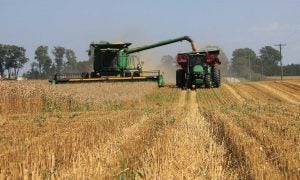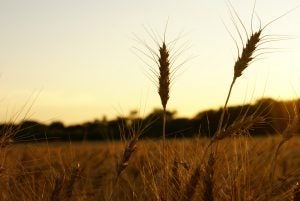Is there a hybrid wheat in your future? Lots of research is being done by the seed industry and academics, but it seems success — like the promise of nuclear fusion — is always a few years away.
The dream of big yield jumps with hybrid wheats has been researched for at least 100 years. Corn hybrids were introduced in the 1930s and doubled yields. Why has it been so difficult to get the same results for wheat growers? To understand why, let’s review how corn hybrids are produced.
Hybrid vigor, the enhanced performance in the F1 (first generation) that exceeds the performance of either parent after crossing two inbred lines, has been observed for at least 150 years. To capture it for the corn farmer, seed companies determine, experimentally, which inbred crosses produce the best performance. They then propagate the two inbred lines. When they have enough seed of both to plant a big field, they plant 4 rows of the intended female plant and 2 rows of the pollinating (male) plant on either side, repeating this pattern across the field. To ensure the female plants don’t self-pollinate, the tassels are removed. After pollination the male plants are destroyed so their seed doesn’t mix with the F1 seed when the combine comes through.
As you can see, hybrid corn seed is expensive to produce, but farmers only use 10 pounds or less per acre, so the yield kick is well worth the expense. They can’t save seed and replant it, of course, because the F2 generation will exhibit many different unproductive gene combinations.
Separating the pollen source (the tassel) from the receptive cob in a corn plant is easy, but for wheat, the anthers (pollen producers) hug the ovary and all are enclosed tightly in the glumes. Pollination occurs behind closed doors, preventing pollination from other sources. In order to make a hybrid, wheat breeders must remove the anthers before they mature, cover the emasculated flowers to keep foreign pollen out, then add pollen from a desired plant when the ovary is ready. The F1 plants from this cross will be uniform. When those seeds are sown, the F2 generation will segregate and the breeder can begin the selection process for a new variety.

So how can this process be accomplished to produce large amounts of F1 seed? The female parent needs to be male sterile and able to accept foreign pollen. The foreign pollen must contain a gene (or genes) that will restore fertility to the female line. Genes for male sterility and restoration are known, but they have to be inserted into a female inbred parent and a male inbred known to produce desirable F1s when crossed. And how do you maintain a seed supply of a male sterile inbred plant? The answer is you maintain a seed supply of a sister (isogenic) line with the same genetics minus male sterility. Call the sterile line “A” and the non-sterile sister line “B.” B is also called the maintainer line.
To produce and maintain large amounts of line A, it is sown in narrow strips next to the B line in a 4:2 ratio. The A and B lines need to have glumes that are not tightly bound to the ovary so that the B line can “leak” lots of pollen into the atmosphere, and the A line can “catch” it. The A and B lines are harvested separately
A third inbred line — called the restorer (“R”) line — that is known to produce copious amounts of pollen and vigorous F1 plants when crossed with the A line, is also maintained. To produce hybrid seed for the farmer, the A and R lines are mixed together in a 95:5 ratio and sown in a field. The harvested seed is sown by the farmer to produce vigorous F1 plants, along with a small amount of R line plants.

Another way to produce hybrids, currently used, is to plant the female parent and male parent in alternating strips across a field, then at the right time a chemical is applied to the female line that kills the pollen. If the timing is correct (and wind or rain can spoil that), the result is a female line that can be harvested separately from the male line, producing male-fertile F1 plants for the farmer the next season There are currently some farmers in Europe growing these hybrids.
So you see producing hybrid wheat seed is an expensive process, and farmers still must seed 1 to 2 bushels per acre. Yield increases so far only amount to 10 percent to 15 percent, not enough to justify the extra cost of the seed. But I think significant yield increases are not far into the future. And just in time to feed an expanding population.
Next month we will examine efforts to develop a perennial wheat.
Jack DeWitt is a farmer-agronomist with farming experience that spans the decades since the end of horse farming to the age of GPS and precision farming. He recounts all and predicts how we can have a future world with abundant food in his book “World Food Unlimited.” A version of this article was republished from Agri-Times Northwest with permission.



